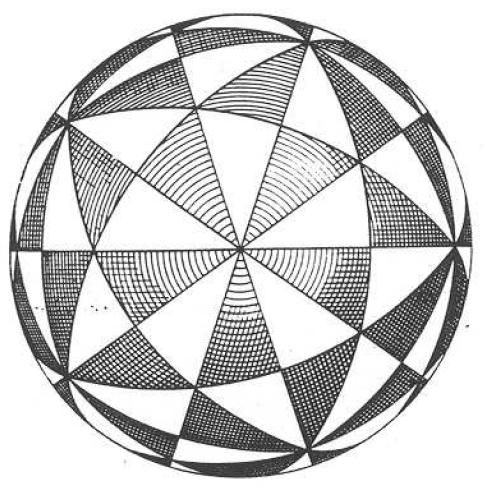Problem - C. I. Valean (Romania)
Prove that
\[\int_0^1\frac{x\ln(1+x)}{1+x^2}\,\mathrm dx=\frac{\pi^2}{96}+\frac{\ln^2(2)}{8}.\]Solution
First we define a new function called $I(\alpha)$ as
$\displaystyle{I(\alpha)=\int_0^1\frac{x\ln(1+\alpha x)}{1+x^2}\,\mathrm dx.}$
Now note that we have the two special values $I(0)=0$ because $\ln(1)=0$, and we also have $I(1)=I$. This is an important fact, we’ll come back to it later.
Lets study the derivative of $I(\alpha)$,
\[\displaystyle{\begin{align*}\frac{\mathrm{d} }{\mathrm{d} \alpha}I(\alpha) &=\int_0^1\frac{\partial }{\partial \alpha}\frac{x\ln(\alpha x+1)}{1+x^2}\,\mathrm dx \\ &= \int_0^1\frac{x^2}{(x^2+1)(\alpha x+1)}\,\mathrm dx\\ &= \int_0^1\left( \frac{\alpha x}{(\alpha^2+1)(x^2+1)}-\frac{1}{(\alpha^2+1)(x^2+1)}+\frac{1}{(\alpha^2+1)(\alpha x+1)}\right )\,\mathrm dx\\ &= \left[ \frac{\alpha\ln(x^2+1)}{2(\alpha^2+1)}-\frac{\text{arctan}(x)}{\alpha^2+1}+\frac{\ln(\alpha x+1)}{\alpha^3+\alpha}\right ]\Bigg\vert_0^1\\ &= \frac{\alpha\ln(2)}{2(\alpha^2+1)}-\frac{\pi}{4(\alpha^2+1)}+\frac{\ln(\alpha+1)}{\alpha^3+\alpha}.\end{align*}}\]Now we integrate w.r.t $\alpha$ and make use of our special values:
\[\displaystyle{\begin{align*}\int_0^1\frac{\mathrm{d} }{\mathrm{d} \alpha}I(\alpha)\,\mathrm d\alpha &=I(1)-I(0) \\ &= I,\end{align*}}\]so
\[\displaystyle{\begin{align*}I &= \int_0^1\left( \frac{\alpha\ln(2)}{2(\alpha^2+1)}-\frac{\pi}{4(\alpha^2+1)}+\frac{\ln(\alpha+1)}{\alpha^3+\alpha}\right )\,\mathrm d\alpha\\ &= \int_0^1\left( \frac{\alpha\ln(2)}{2(\alpha^2+1)}-\frac{\pi}{4(\alpha^2+1)}\right )\,\mathrm d\alpha+\int_0^1\frac{\ln(\alpha+1)}{\alpha^3+\alpha}\,\mathrm d\alpha\\ &= \frac{\ln^2(2)}{4}-\frac{\pi^2}{16}+\int_0^1\left( \frac{\ln(\alpha+1)}{\alpha}-\frac{\alpha\ln(\alpha+1)}{\alpha^2+1}\right )\,\mathrm d\alpha.\end{align*}}\]The information this tells us is that $I$ satisfies the relation
\[\displaystyle{I=\frac{\ln^2(2)}{4}-\frac{\pi^2}{16}+J-I}\]where
\[\displaystyle{J=\int_0^1\frac{\ln(\alpha+1)}{\alpha}\,\mathrm d\alpha.}\]If we could just evaluate $J$ then we could solve for $I$!
Fortunately, evaluating $J$ is actually quite easy if we make use of the Mercator series,
\[\displaystyle{\begin{align*}J &=\int_0^1\frac{1}{\alpha}\sum_{n=1}^\infty\frac{(-1)^{n+1}}{n}\alpha^n\,\mathrm d\alpha \\ &= \int_0^1\sum_{n=1}^\infty\frac{(-1)^{n+1}}{n}\alpha^{n-1}\,\mathrm d\alpha\\ &= \sum_{n=1}^\infty\frac{(-1)^{n+1}}{n}\int_0^1\alpha^{n-1}\,\mathrm d\alpha\\ &= \sum_{n=1}^\infty\frac{(-1)^{n+1}}{n^2}\\ &= \eta(2)\\ &=\frac{\pi^2}{12}.\end{align*}}\]Where $\eta(s)$ is the well-known Dirichlet eta function.
Therefore
\[\displaystyle{I=\frac{\ln^2(2)}{4}-\frac{\pi^2}{16}+\frac{\pi^2}{12}-I}\]and solving for $I$ gives
\[\displaystyle{\int_0^1\frac{x\ln(1+ x)}{1+x^2}\,\mathrm dx=\frac{\pi^2}{96}+\frac{\ln^2(2)}{8}}\]as desired.
